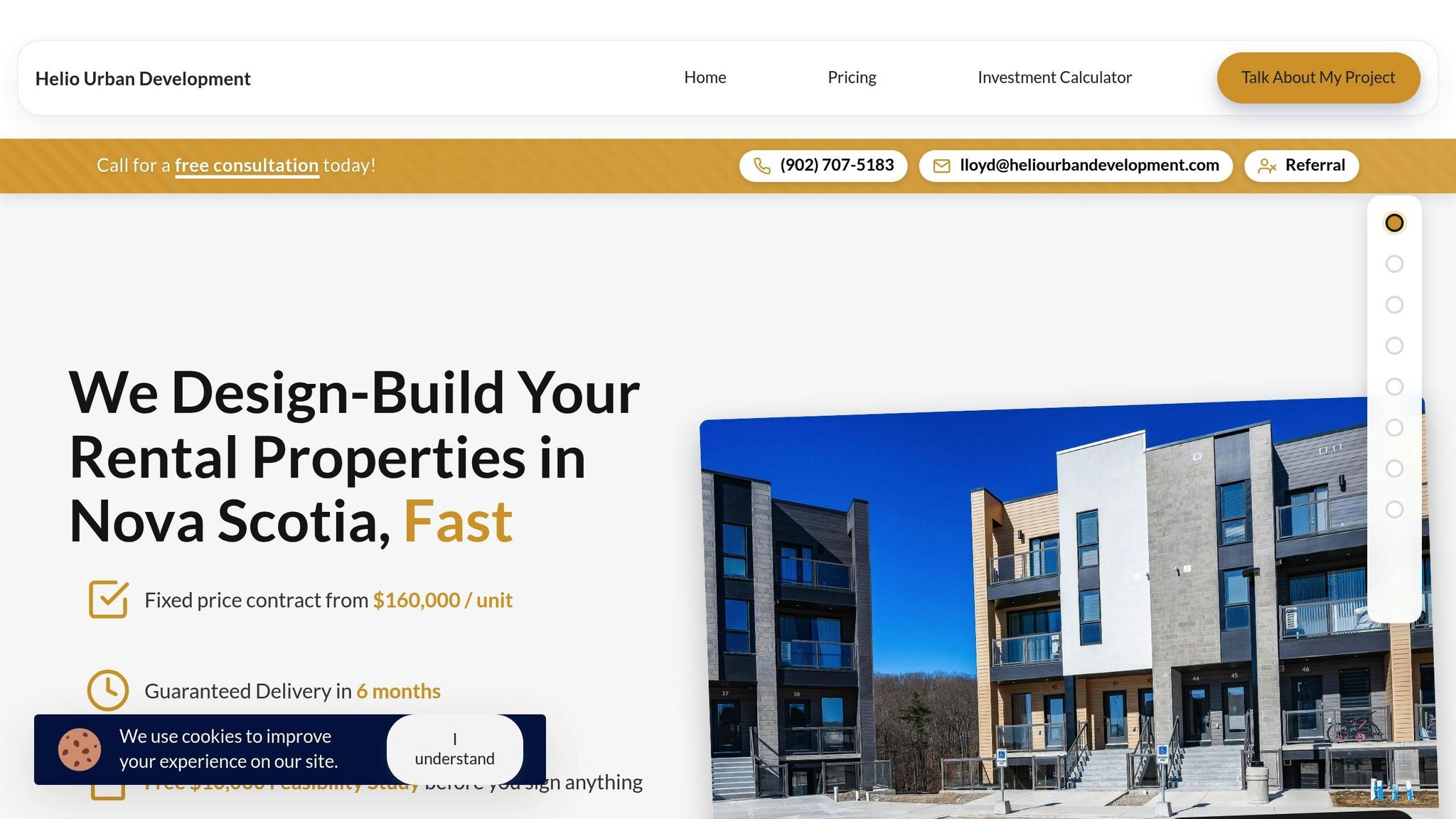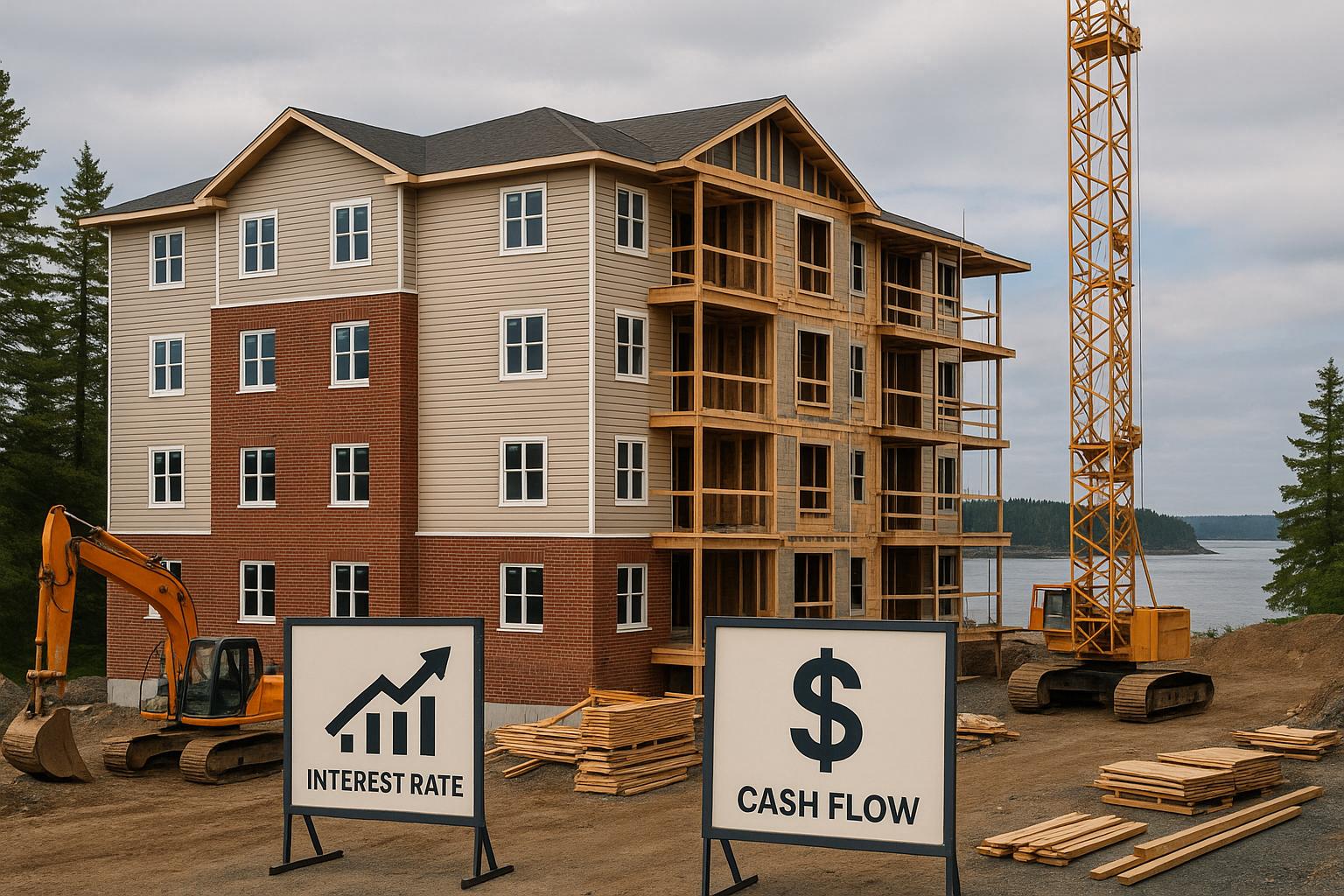If you're building purpose-built rental housing in Halifax, you can recover the entire 15% Harmonized Sales Tax (HST) paid on construction costs through a federal rebate program. This rebate applies to eligible expenses like labour, materials, permits, and professional services, making rental housing projects more financially viable. However, strict eligibility criteria, documentation requirements, and deadlines must be met to claim the rebate.
Key Points:
- HST Rate: 15% on construction costs in Nova Scotia.
- Rebate: 100% refund for purpose-built rental housing projects.
- Eligibility: Rental units must remain tenant-occupied for at least one year post-construction.
- Expenses Covered: Labour, materials, permits, and professional services (excluding land, legal, and financing costs).
- Application Deadline: Within two years of completing construction or paying the HST.
For example, if you spend $800,000 on construction, you can recover $120,000 in HST, reducing your overall cost by 15%. This rebate can improve cash flow, lower financing needs, and boost ROI. To simplify the process, working with an integrated construction team ensures proper documentation and timely applications.
Build to BRRRR Triplex in Windsor | Exact 2025 Costs, $2K/Month Cash Flow & $80K HST Rebate
Who Qualifies for the 100% HST Rebate
Not all rental housing projects are eligible for the HST rebate. To avoid costly errors, it’s essential to understand the eligibility criteria outlined in federal and provincial guidelines.
Property Owner Requirements
To qualify, the property must be exclusively intended for rental use and consist of self-contained units, each equipped with a kitchen, bathroom, and separate entrance. Property owners who have claimed HST input tax credits are not eligible for this rebate. It’s also crucial to review which construction costs qualify to ensure your project meets all the necessary conditions.
Qualifying Construction Costs and Projects
The rebate applies to HST paid on specific construction-related expenses. Eligible projects include new builds or major renovations that add rental units. Converting non-residential buildings into residential rental housing may also qualify, provided the resulting units meet the required standards.
Qualifying expenses can include:
- Labour costs
- Building materials
- Professional services like architectural and engineering fees
- Permits and inspection fees
- Site preparation work
However, certain costs are excluded, such as land acquisition, legal fees, and financing expenses. Essential landscaping and utility connections might qualify if they are integral to the project. These criteria align with Nova Scotia’s specific rebate rules, which are discussed further below.
Nova Scotia Rebate Rules
In Nova Scotia, rebate applications follow federal guidelines but also include unique provincial considerations. The property must be intended for long-term rental use, not short-term or vacation rentals. Applications must be submitted within the specified timeframe and include proper documentation, such as invoices, receipts, and contracts that verify HST payments.
The rebate is calculated based on the fair market value of the property at completion, rather than the total construction costs. Each residential unit must meet local building codes, ensuring it has self-contained sleeping, cooking, and bathroom facilities. Additionally, the project must comply with local zoning and regulatory requirements. Collaborating with professionals familiar with these standards can help ensure your project remains eligible for the rebate.
How to Apply for the HST Rebate
Applying for the HST rebate involves gathering the right documents and following a clear process. Missing any required forms or paperwork can cause delays, so it’s important to get everything in order.
Required Documents and Forms
The cornerstone of your application is Form GST524, which is specifically for the New Residential Rental Property Rebate. You can download this form from the Canada Revenue Agency (CRA) website or request a paper copy by calling 1-800-959-5525. This form asks for detailed information about your property, including construction costs and its intended use as a rental.
Make sure to include original receipts and invoices that show the HST amounts, vendor details, and project specifics. If you’re submitting photocopies, you’ll need to attach a statutory declaration to validate them. Construction contracts and agreements are also critical, as they confirm the scope of your project and associated costs. These should include agreements with builders, subcontractors, architects, and engineers that clearly list HST charges. If you’ve worked with an integrated builder like Helio Urban Development, having a single contract simplifies this step significantly compared to managing multiple agreements.
Additionally, you’ll need occupancy permits or certificates of completion, which prove that your rental units comply with building codes and are ready for tenants. These documents are typically issued by your local building department once the project is finished.
Finally, provide proof of rental intent to demonstrate that the property is intended for long-term rental use. This can include lease agreements, rental ads, or property management contracts. The CRA requires this evidence to ensure the rebate isn’t being claimed for personal use or short-term rentals.
Once all your documents are in hand, you’re ready to submit your application.
Submitting Your Application
Timing is everything when it comes to submitting your application. You must do so within two years of the end of the month in which you either paid the HST or completed your rental property project - whichever comes later. This deadline is firm, and late submissions will be rejected.
You can send your completed GST524 form and all supporting documents by mail or through the CRA’s online portal using your business number. Be sure to keep copies of everything you submit, and if mailing your application, include proof of delivery for added security.
The CRA usually processes applications within 8 to 12 weeks, though more complex projects may take longer. To check on your application status, you can call the GST/HST Rulings Centre at 1-800-959-8287 or log in to your CRA account online.
When it comes to receiving your rebate, payments are made via direct deposit (if you’ve provided your banking information) or by cheque sent to your registered address. Direct deposits typically arrive within 5 business days, while cheques may take 2–3 weeks.
Rebate Calculation Example
Let’s break this down with an example. Imagine a property owner in Halifax building a fourplex with total construction costs of $640,000. Nova Scotia’s HST rate is 15%, which means the total HST paid comes to $96,000 ($640,000 × 15%).
Looking at the per-unit breakdown, each unit costs $160,000 to build, resulting in $24,000 HST per unit ($160,000 × 15%). Since the rebate program allows for a full refund, each unit qualifies for the entire $24,000 back.
For the entire fourplex, the total rebate amounts to $96,000 ($24,000 × 4 units). This means the property owner recovers all the HST paid on eligible construction costs, significantly boosting the project’s financial outcome.
The cash flow benefit is substantial. Receiving a $96,000 rebate within 8–12 weeks of approval can help property owners reduce construction loans or reinvest in other projects. For those using integrated construction services, the rebate process can be even smoother, thanks to simplified documentation under a single contract.
sbb-itb-16b8a48
Financial Impact of the HST Rebate
For eligible purpose-built rental housing in Halifax, property owners can significantly cut construction costs when the full 15% HST is refunded. Let’s break it down with some examples to see just how impactful this rebate can be on project budgets and overall financial performance.
Cost Comparison With and Without the Rebate
Take a fourplex project with a base construction cost of $640,000. Normally, with the 15% HST applied, the tax adds $96,000, bringing the total to $736,000. But with the rebate, that $96,000 is refunded, reducing the overall cost back to $640,000. Here's a clearer look at the numbers:
| Cost Component | Without Rebate | With 100% Rebate | Savings |
|---|---|---|---|
| Base Construction Cost | $640,000 | $640,000 | $0 |
| HST (15%) | $96,000 | $96,000 | $0 |
| HST Rebate Received | $0 | $96,000 | $96,000 |
| Net Construction Cost | $736,000 | $640,000 | $96,000 |
| Cost Per Unit | $184,000 | $160,000 | $24,000 |
For larger projects, the savings multiply. An eight-unit building with a $1.28 million construction cost would see $192,000 in HST savings, while a twelve-unit project would save $288,000. These savings can be reinvested into adding more units, upgrading finishes, or even funding future developments. This directly boosts cash flow and enhances the overall return on investment (ROI).
Cash Flow and ROI Benefits
- Better Cash Flow: Once the rebate is processed (typically a few months after approval), the refunded amount can be used to reduce construction loans or fund new projects.
- Higher ROI: Using the fourplex example, with each unit renting for $1,950 per month (or $93,600 annually), the ROI without the rebate is about 12.7% ($93,600 ÷ $736,000). With the rebate lowering costs to $640,000, the ROI jumps to 14.6%.
- Quicker Payback: A $96,000 saving accelerates the payback period by roughly a year, allowing property owners to reinvest their equity sooner.
Additionally, with a lower loan-to-value ratio, property owners may qualify for better interest rates or even avoid mortgage insurance altogether. Some even use the rebate as a down payment for their next project, turning one development into a stepping stone for portfolio growth. These benefits align well with streamlined construction models, which can further reduce costs and repayment times.
Case Study: Fourplex Development Savings
To illustrate, here’s a real-world example: A property owner partnered with Helio Urban Development to build a fourplex. The contract cost was $640,000, with $96,000 in HST charges eligible for the rebate.
Project Timeline & Process:
- Construction wrapped up in six months.
- Occupancy permits were issued in the seventh month.
- The HST rebate arrived by month nine.
Financial Impact:
Initially, the owner budgeted $736,000 for the project. After receiving the $96,000 rebate, the actual cost dropped to $640,000. The rebate allowed the owner to reduce the construction loan by $50,000 and allocate $46,000 as a down payment for a new project.
Long-Term Results:
This efficient use of the rebate not only lowered financing costs but also sped up the owner’s ability to reinvest, enabling faster expansion into future developments.
Getting the Most from Your Rebate with Integrated Construction
The HST rebate is a fantastic way to save money, but to make the most of it, you need precise execution and accurate documentation. The construction method you choose can be the deciding factor between maximizing your rebate or facing delays that might put your eligibility at risk.
Integrated Design-Build vs. Multiple Contractors
Traditional construction often involves coordinating several independent contractors, which can lead to miscommunication and delays. This fragmented approach frequently results in budget overruns and project timelines that stretch far beyond expectations.
In contrast, the integrated design-build approach brings all professionals together as a single, cohesive team from the start. This method minimizes miscommunication and scheduling conflicts, which are common when managing multiple contracts. On average, property owners save about $47,000 in coordination costs when using a unified team under one contract.
Beyond cost savings, this streamlined approach ensures reliable documentation and timely rebate applications. Delays in project completion can affect rental income and make it harder to meet the strict deadlines and documentation requirements for HST rebate eligibility. With fixed-price contracts and guaranteed timelines, the integrated design-build method safeguards your budget and keeps your rebate on track.
Protecting Your Rebate with Expert Coordination
The design-build model also offers expert coordination, which is critical for managing the HST rebate process. These rebates demand meticulous documentation and adherence to deadlines. By working with an integrated construction team, you can ensure that every qualifying expense is properly recorded and all paperwork is handled efficiently. This reduces the risk of errors that could delay your rebate.
This level of transparency becomes even more crucial in the final stages of the project, where obtaining occupancy permits and passing inspections are key to securing your rebate and maximizing savings.
Case Study: Helio Urban Development's Fixed-Price Model

Helio Urban Development, based in Nova Scotia, is a prime example of how an integrated design-build approach can enhance rebate benefits. Specializing in 4+ unit rental properties, Helio was founded by ex-investment banker Lloyd Liu and data scientist Yuan He. The company addresses three major issues often seen in traditional construction: coordination problems, budget overruns, and timeline delays.
Helio operates on a six-month fixed timeline, with penalties of $1,000 per day for delays, ensuring on-time project completion. This approach protects rebate eligibility and helps property owners stick to rental income schedules. As Lloyd Liu, Co-Founder & CEO of Helio Urban Development, explains:
"I personally guarantee every timeline because I've felt the pain of construction delays."
Currently, Helio has 31 units under construction and 131 more in the planning stages. They’ve consistently delivered projects within six months - a significant improvement over the industry average of 12–18 months - while avoiding budget overruns. Their fixed-price model, averaging $160,000 per unit, offers cost certainty that traditional cost-plus contracts can't match.
Helio also provides triple quality verification through P.Eng inspections and a two-year warranty, ensuring that projects meet all rebate requirements while maintaining high construction standards. Their advanced scheduling system further eliminates delays that could complicate rebate applications.
For property owners developing fourplexes or larger projects, this integrated approach not only secures the HST rebate but also supports an annual ROI of 12–20%. In Halifax’s growing rental market, purpose-built housing has become a profitable and efficient investment strategy.
Key Points for Property Owners
Let’s break down the benefits for property owners. First, the 15% HST rebate on qualifying rental housing projects can significantly lower construction expenses, helping to improve your return on investment (ROI). The eligibility requirements for accessing this rebate are clear and manageable, making it a practical option for many.
To qualify, your project must focus on a multi-unit rental property with at least four units, built on your own land. The rebate applies to eligible construction costs, including materials, labour, and professional services. Thanks to these savings, property owners often see an annual ROI of 12–20% when renting units at market rates of $1,950–$2,100 per month. This can shorten the payback period considerably.
Documentation plays a crucial role in securing the rebate. You’ll need detailed records, proof that the property is rental-ready, and evidence of code compliance. Missing paperwork or deadlines can put your rebate at risk. Choosing an integrated design-build construction approach can simplify the process. This method minimizes coordination issues, reduces extra costs, and ensures all required documentation is prepared for your rebate application. Plus, fixed pricing and guaranteed completion timelines offer extra peace of mind, safeguarding both your rebate eligibility and your rental income schedule.
With Halifax experiencing rising demand for rental housing, this rebate creates a strong case for investing in purpose-built rental properties. Instead of buying existing properties, constructing new rental units can offer better financial outcomes. The combined effect of tax savings, robust rental income, and streamlined construction processes can deliver immediate positive cash flow, making this an excellent opportunity for expanding your portfolio.
FAQs
What documents do I need to apply for the 100% HST rebate on purpose-built rental housing in Halifax?
To claim the full HST rebate for purpose-built rental housing in Halifax, you'll need to present proof of purchase for building materials and evidence that the rental units meet the eligibility requirements. This could include items like invoices, contracts, and documentation showing the property is intended for long-term rental use.
Make sure you keep all your supporting documents well-organized and easily accessible, as they might be needed during the review process. Staying on top of your records can make the rebate application much simpler.
How does using a design-build approach help property owners get the most out of the HST rebate for rental housing projects?
The design-build method offers property owners an effective way to make the most of the HST rebate by encouraging early collaboration between designers and builders. This team-oriented approach helps keep projects on track, reduces delays, avoids surprise expenses, and ensures everything stays within budget and scope.
By simplifying both the planning and construction phases, property owners can confidently meet the criteria for the 100% HST rebate on purpose-built rental housing. This not only makes the process smoother but also lowers overall costs, enhancing the financial returns of your rental property project.
What common mistakes should property owners avoid when applying for the HST rebate on purpose-built rental housing in Nova Scotia?
When applying for the HST rebate in Nova Scotia, property owners often run into a few common mistakes that can cause delays or even disqualify their application. A big one is not meeting the eligibility criteria. For example, the fair market value of the property must fall within specific limits - like being under $450,000 for the federal portion of the rebate. It's crucial to double-check these details before submitting your application.
Another frequent issue is incomplete or inaccurate paperwork. Forms like the GST189 need to be filled out completely and paired with all the required supporting documents. Even small errors or missing information can slow down the process or lead to a rejection. Lastly, make sure you submit your application on time. Missing the deadline could mean losing out on the rebate entirely. Taking the extra time to review everything carefully can save you from unnecessary headaches and help you secure your savings.



